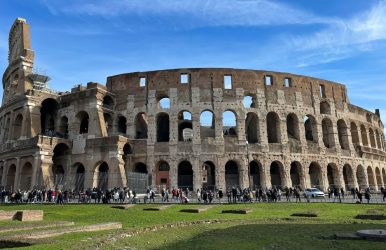Gladiators In Ancient Rome: Blood, Glory, And The Legacy You Can Still Feel Today
BY Barsha May 27, 2025
Few Roman emblems are more recognizable and evocative than that of the gladiator. These violent men—half athlete, half captive, half myth—held Roman crowds for centuries in bloody battles that were spectacle as much as they were a matter of conquest. But who were the gladiators in Rome, in reality? What motivated thousands of onlookers to celebrate their fate in the arena? And where can you still sense the beat of their legacy today? Further, Rome, the capital of Italy, is about to host the 2025 World Travel & Tourism Council’s (WTTC) summit. Also, the historical places to visit in Rome play a vital role in maintaining Italy’s position as the number one travel destination in the world. If you are not in the know, Italy has just won the laurel of the top luxury tourism destination for 2025 at the International Luxury Travel Market (ILTM) Latin America. So, in this Tour and Travel Guide, we will find out the gladiators of Rome and how they can be the highlight for your next vacation to Rome. At the same time, we will talk about the historical places of Rome and why they make the city the most preferred destination in the world. From Funerary Rites To Public Spectacle: The Gladiators Of Rome And Their Timeless Appeal The origin of the gladiators in Rome is very much intertwined with sacrifice and ritual in the natural world. Ancient accounts indicate that gladiatorial fighting was once performed in remembrance of the dead, particularly renowned figures from society. These events later became popular for entertaining or intimidating the masses. By the Roman Republic, games of gladiators already were a political weapon: a show of grandeur and munificence employed to win the favor of the masses. The Colosseum: Heart Of The Arena The Colosseum, or Flavian Amphitheater, was the spectacular arena for the events. Finished in 80 AD by Emperor Titus, it could accommodate as many as 50,000 spectators and saw colossal games which lasted for 100 successive days at times. Gladiators drew swords here, man-eating animals from Africa and Asia were brought out, and emperors gained or lost the people's favor in the arena of blood. So, the Colosseum, an icon of ancient Roman civilization, is more than just an architectural marvel. The use of concrete and innovative techniques in the Colosseum was unique. However, the more unique aspect of the place is how it witnessed and has carried the history of the gladiators of Rome and a particular way of Roman living over the years. In other words, the next time you visit the Colosseum, one of the best things to do in Rome, you will have a new perspective as a traveler. And yet, glorious as the Colosseum stands, its actual history truly comes alive only when viewed in context—through the unseen narratives of the Ludus Magnus (the main gladiator school), the pre-fight rituals, and the political maneuvering behind each bout. Want to Experience The Legacy Of Gladiators In Rome Like Never Before? If you're planning a visit to Rome, seeing the Colosseum is a must, but walking around its outer walls is just scratching the surface. For a deeper, more immersive journey into the world of ancient warriors, book a Colosseum-focused city tour with Golf Cart Tours. Their small-group, open-air tours are led by expert guides who blend storytelling, history, and modern comfort. No exhausting uphill hikes or crowded buses. Just an engaging, up-close experience that brings Rome’s gladiatorial past to life. Your guide will take you beyond the arena to the key sites tied to the games, including Janiculum Hill, Capitoline Hill, and the Forum, sharing insights you won’t find in guidebooks. The best part? The Golf Cart Tours team knows how to make history unforgettable—even for kids and families. You’ll leave not just with photos, but with stories. Life, Death, And The Role Of The Gladiators In Rome Most of the gladiators, though, were captive males, captives of war, or convicted criminals to be killed in the arena. Yet, not all. Free men also came into the profession of their own free will, attracted by the prospect of fame, wealth, or even salvation. These volunteers, known as Auctorati, were typically contracted for several years, with service agreements that would make them both legendary and infamous. In the schools of training (Ludi), gladiators became the machines to kill. They were divided into specialized classes according to combat style and weaponry: Retiarii (net and trident) Murmillones (sword and buckler) Secutores Thraeces, and others. Despite their cruelty, gladiators were popular. They had girlfriends, they had fans, and they even had political power. Gladiators' faces were found in mosaics, in graffiti, and even on coins. Some, such as Spartacus or Flamma, even became legends. The Historical Places In Rome Are Much Beyond The Arena The gladiators themselves are no more, but their legend still towers over the Eternal City. Each cobblestone street and crumbling ruin holds a tale, and some of the biggest are the ones where the gladiators fought, breathed, and died under the bellow of 50,000 Roman throats. However, the historical attractions in Rome are beyond the arena. Here are the other crown jewels. 1. Sistine Chapel: The House Of The Last Judgment The Sistine Chapel in Rome features "The Last Judgment," a famous artwork by Michelangelo. Furthermore, it has breathtaking frescoes. 2. St. Peter's Basilica: The Most Revered Catholic Church In The World Though located in the Vatican City, St. Peter's Basilica is one of the iconic religious and historical landmarks in Rome. Furthermore, it is the most important Catholic church, and it is the burial site of Saint Peter. He was one of the apostles of Jesus Christ, and he was the first pope. Moreover, the Renaissance and Baroque architecture of the church makes it a place of awe and wonder. 3. Piazza Navona You cannot miss a visit to Piazza Navona, which is a public square in Rome. It has palatial buildings and baroque fountains. So, there is always a lively atmosphere around the square.



















